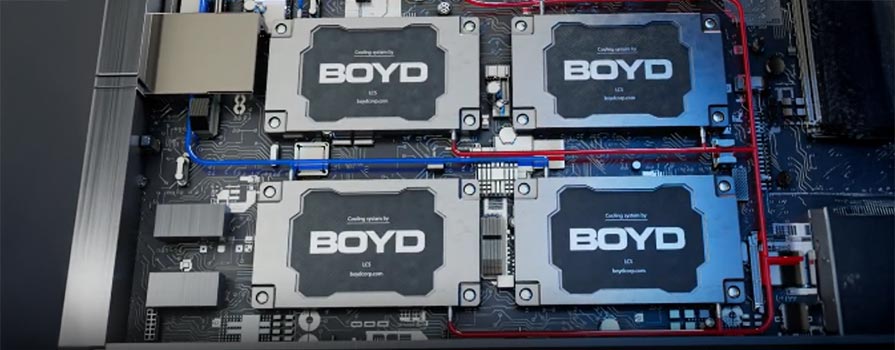How to Calculate Which Fan is Right for Your Application
The most well known type of heat exchanger is a car radiator. In a radiator, a solution of water and ethylene glycol, also known as antifreeze, transfers heat from the engine to the radiator and then from the radiator to the ambient air flowing through it. This process helps to keep a car’s engine from overheating. Similarly, Boyd’s heat exchangers are designed to remove excess heat from aircraft engines, optics, x-ray tubes, lasers, power supplies, military equipment, and many other types of equipment that require cooling beyond what air-cooled heat sinks can provide.
One of the most important parameters in air-to-liquid cooling applications is airflow. To calculate the airflow required to cool a process, one must know the amount of heat to be dissipated and the change in air temperature. Airflow alone, however, is not sufficient in selecting a fan. System impedance along the air path must also be calculated. Airflow and system impedance define the fan operating point necessary to cool a process. When selecting a fan for a heat exchanger, some other considerations include fans versus blowers, constant or variable flow, and AC or DC power.
Establishing Airflow Requirements




This is the airflow needed to dissipate the heat generated inside the cabinet at STP conditions. It should be noted that the mass of air, not its volume, determines cooling capacity.
Determining System Impedance


This equation describes the relationship between static pressure and the airflow required in a particular system.
Going back to the previous example, using equation 4 we calculate static pressure through the cabinet to be 0.11 inches of water. In this application, there is up to 1 gpm of available facility water at 52°F (11°C). We need to select a fan that can provide at least 27 CFM of airflow at 0.11 inches of water and a heat exchanger that has the following performance when using water at 1 gpm or less:

ITD is the Initial Temperature Difference between the incoming hot air and cold water.
As Figure 1 below indicates, 6105 copper tube-fin heat exchanger will provide 6.9 W/°C when paired with a fan that can provide at least 27 CFM and water flow greater than 0.25 gpm. If we select an Oriental Motor fan model MU1225S as shown in Figure 2, the pink vertical and horizontal lines show that at the required 0.11 inches of water this fan will provide 39 CFM, this is well over our requirement of 27 CFM. It’s important to note, however, that fan accessories such as finger guards and filters can have an impact on fan performance, as shown by the difference between airflows at points A, B, and C in Figure 2. In a high impedance system such as our example, the effect on fan performance is minimal. With a low impedance system though, the impact to fan performance can be greater. If our cabinet had a clear airflow path, system impedance would be relatively low and accessories would have a significant impact on fan performance, as shown by the airflow differences between points D, E, and F on Figure 1. Any significant drop in airflow from the required amount will impact the performance of the heat exchanger.
In addition to airflow and system impedance, other important factors must be considered when selecting a fan such as fan type, constant or variable flows, AC or DC power, air density, noise, life expectancy, EMI/RFI interference, and more.


Axial Fan or Blower
After identifying the system impedance and overall required airflow, the next consideration is generally what type of fan to use. The most prevalent types of fans are axial fans and blowers. An axial fan moves air in a direction parallel to the direction of the fan blade axis. They work well under low static pressure conditions and are preferred when low noise is a requirement. Blowers are centrifugal in design, with the air moving perpendicular to the axis of rotation. They are suitable for high-pressure applications, such as telecommunications and high-end servers, and operate at maximum efficiency near their peak static pressure.
Constant or Variable Flow
Fans are often oversized because the sizing calculations were based on worst-case scenarios. For example, a fan may be sized based on the maximum heat dissipation required or based on an extremely high ambient temperature. In this case the extra performance provided by an oversized fan may only be needed in extreme situations. For many operating phases, a considerably lower airflow rate would be sufficient. For example, using lower airflow for lower ambient temperatures or when devices are only operated with a partial load. “Intelligent” fans are an effective solution for such applications where adaptation to changing conditions is necessary. With this type of temperature-dependent fan control, the speed drops when the thermal load is low. Consequently, noise emission and power requirement decrease.
AC or DC Fans
Your system’s available power may dictate the type of fan. If your application is power flexible, you should weigh the merits of a DC versus AC fan. A DC fan provides variable flow while an AC fan provides constant flow. In the past, DC fans were significantly more expensive than AC fans. Today, the price difference is almost non-existent and one can make decisions based more on performance and functionality. Even though AC fans are still widely used today, DC fans boast longer life, approximately 60% less power consumption, and lower levels of EMI (Electro Magnetic Interference) and RFI (Radio Frequency Interference).
When selecting a fan for a heat exchanger, it is important to look not only at cooling requirements and system impedance, but also at fan type, constant or variable flow, and AC or DC power operation. Further down in this post additional fan considerations such as life expectancy, air density, noise, and EMI/RFI interference will be discussed.
How to Calculate Which Fan is Right Continued…
In air-to-liquid or liquid-to-air cooling applications, airflow is one of the most important parameters to consider. Therefore, selecting the right fan is just as important as selecting the right heat exchanger. We calculated airflow and system impedance requirements and discussed selection factors such as AC or DC power, constant or variable flow, and the choice of a fan or blower. This article will discuss other important heat exchanger fan selection factors such as air density effects, noise, life expectancy, and EMI/EMC interference.
Air Density Effects


| Condition | Density (lbs/ft3) | Mass Flow Rate (lbs/hr) |
|---|---|---|
| Sea Level, 70°F | 0.075 | 1350 |
| Sea Level, 250°F | 0.056 | 1008 |
| 10,000 ft, 250°F | 0.038 | 684 |
Noise
Another important factor when selecting a fan is noise. Noise has no direct effect on fan performance, but it needs to be considered when selecting a fan for two important reasons. First, noise can affect work efficiency, or, in some extreme cases, can cause long-term hearing problems. Standards such as OSHA’s (U.S. Occupational Safety and Health Administration) Occupational Noise Exposure – 1910.95, limit exposure to various sound levels without hearing protection so that loss of hearing does not occur.
Secondly, noise can have a significant effect on the system’s operation and overall reliability. Noise can affect the function of some electronic devices, which may act as vibration absorbers and become fatigued by the vibration. Also, some operating environments such as laboratories contain noise sensitive instrumentation.
Fan design can minimize broadband noises generated by air separation from the fan blade surface and trailing edge. Noise can be minimized by proper pitch angle and notched or serrated trailing blade edges. Our high performance Double Width Double Inlet (DWDI) Blowers are designed specifically to mitigate acoustics and reduce noise levels for improved user experience and reduced ambient vibrations for sensitive devices.
Life Expectancy
Fan life expectancy is defined as the period of time a fan can be operated continuously without losing significant rotational speed or emitting so much noise that it can no longer be used. Fans typically require a long life without failure to provide high system reliability. Bearing failure causes most fan failures. However, unlike motor or gear-head bearings that carry very large loads, bearings used on cooling fans typically have negligible loads. Therefore, fan life can be determined by the deterioration of the lubricant in the bearings. Since fans have low running and starting torque compared with motors used to drive heavy machinery, they will not rotate properly if the lubricant deteriorates. If this occurs, starting voltage will increase and the fan may not start. Deterioration of lubricant also increases fan noise generated by the bearings.
The two most widely used methods for specifying fan life are the more commonly used L10 life method and MTBF (Mean Time Between Failures). The difference between the two is that L10 life specifically refers to the amount of time it takes for 10% of a group of fans to fail. MTBF for fans can be approximated as the time when 50% of fans have failed. Fan L10 lives are typically in the range of 60,000-70,000 hours under normal operating conditions of between -40°C and 50°C at 75% RH. MTBF life ranges are typically between 200,000–300,000 hours under the same conditions.
For long life expectancy, high quality ball bearing fans are considered the most reliable. When using an L10 method to compare life expectancy of sleeve bearing and ball bearing fans at temperatures ranging from 25°C-60°C, ball bearing fans outlast sleeve-bearing fans by 50% on average. In general, there is not much difference in life between sleeve and ball bearing fans when the temperatures are close to ambient. Traditionally, ball bearings provided a longer life than sleeve bearings in fan motors at high ambient conditions. Recent technical improvements in fluid lubricant bearings (FLB) like those used in our standard Axial Fans and sintered sleeve bearings have led to reliability figures at least as good as ball bearings at significantly lower costs.
EMI and EMC interference
Another variable in fan selection is EMI (Electromagnetic Interference) and EMC (Electromagnetic Compatibility). EMI, by definition, is any electrical imposition that can interfere with the normal operation of equipment. There are two broad areas of EMI interference: conducted interference and radiated interference.
Conducted interference refers to any undesired signal conducted through power and signal lines. Radiated interference refers to any undesired signal that radiates from a source and may affect the normal operation of equipment. Conducted EMI is usually more of a problem than radiated EMI. In fact, when dealing with brushless DC fans, conducted EMI is normally the only concern.
Typically, AC induction motors running sine wave voltages do not present EMI concerns. There may, however, be small magnetic interference present close to the motor and its input leads. DC motors, either mechanically or electronically commutated, and AC motors powered by electronic controllers have EMI signatures. EMI is produced by the switching of the DC voltage, which is necessary to produce rotation of the magnetic fields in the motor.
EMC (Electromagnetic Compatibility) can best be described as the ability of equipment to operate without generating unwanted electromagnetic interference that can affect the operation of other electronic equipment, as well as its ability to not be negatively affected by unwanted interference generated elsewhere.
In summary, fan selection is a very important part of liquid-to-air and air-to-liquid cooling applications. It takes more than just airflow and static pressure calculations to size the proper fan for an application. As discussed in part 1 and 2 of this article, there are some other very important factors that must be considered by a designer when sizing a fan to provide a reliable system. These include air density effects, noise, life expectancy, and EMI/EMC interference.
Learn more about our Axial Fans and our High Performance Double Width, Double Inlet (DWDI) Blowers.






